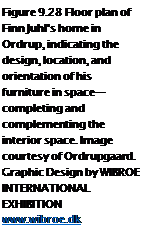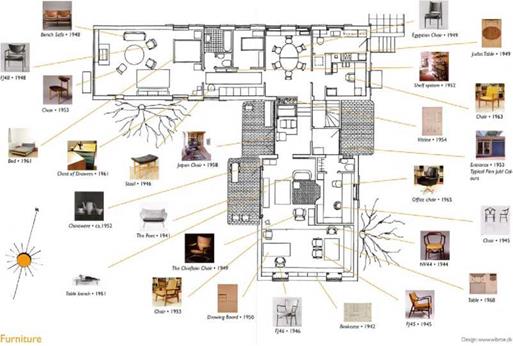Danish furniture was highly regarded in the twentieth century for its craft in wood. Beech, birch, pine, and white oak were abundantly available and used to make furniture for years. In the 1960s, the quality of Danish furniture inspired industrial companies to sustain a high standard of design in their products. Fritz Hansen, PP Mobler, and Rud. Rasmussen of Copenhagen achieved high standards in production (Figures 9.24, 9.25, and 9.26). Although Finland is technically not a Scandinavian country, it is culturally and socially considered
 Scandinavian. The Finnish company Artek, located in Helsinki, helped to promote Scandinavian design throughout the world with the fabrication and distribution of the furnishings designed by Alvar Aalto and other notable Finnish designers.
Scandinavian. The Finnish company Artek, located in Helsinki, helped to promote Scandinavian design throughout the world with the fabrication and distribution of the furnishings designed by Alvar Aalto and other notable Finnish designers.
Scandinavian furniture design, as it is known today, came about because a handful of world-class designers emerged from the same place, at the same time. During the 1950s, Arne Jacobsen, Verner Panton, Hans J. Wegner, Borge Morgensen, Finn Juhl, and Poul Kjsrholm all sought the combination of function and refined beauty that presents itself in a natural way. Scandinavian furniture is notable for its restraint, workmanship, and direct correlation between form and function. Today, younger designers such as Niels Hvass and companies such as Komplot Design; Hay, Hansen & Sorensen; and GUBI are carrying the Danish tradition of furniture design and craft into the twenty-first century (Figure 9.27).
Of the many talented Danish furniture designers of the midtwentieth century, Finn Juhl (1912-1989) had a particularly remarkable career. He was an architect and interior and industrial designer who designed his own home in 1942 and all the furniture in the home (Figure 9.28). The interior spaces within his home at Kratvaenget in Ordrup, just outside Copenhagen, are Figure 9.24 Arne Jacobsens Swan chairs at Fritz Hansens press furnished by his personal organic designs. They embody the room. Photography by Jim Postell, 2006.
|
|
|
|
|
|

practical, comfortable, human-sized furniture that became known as Scandinavian furniture design. Of particular interest is the spatial and modest relationship that his furniture has with interior space. Finn Juhl saw his furniture as part of the expression of a room, complementing and completing the architectural setting—his own house being a case study in this idea and arguably embodied the spirit of Danish design at the time.
 |
 |
Other Epicenters
A short list of furniture epicenters throughout the world would include Paris, France; Barcelona, Spain; London, England; Amsterdam, Netherlands; Chicago, Illinois; Grand Rapids, Michigan; Highpoint, North Carolina; East Aurora, New York; and New York City. These epicenters often specialize in production, design, distribution, or marketing of furniture. Each region maintains an industrial or design presence that has been developed and recognized as a center for a substantial period of time. Local regions and countries have invested in design centers and recognize how furniture design contributes to regional economies.





